Презентация welding-presentation


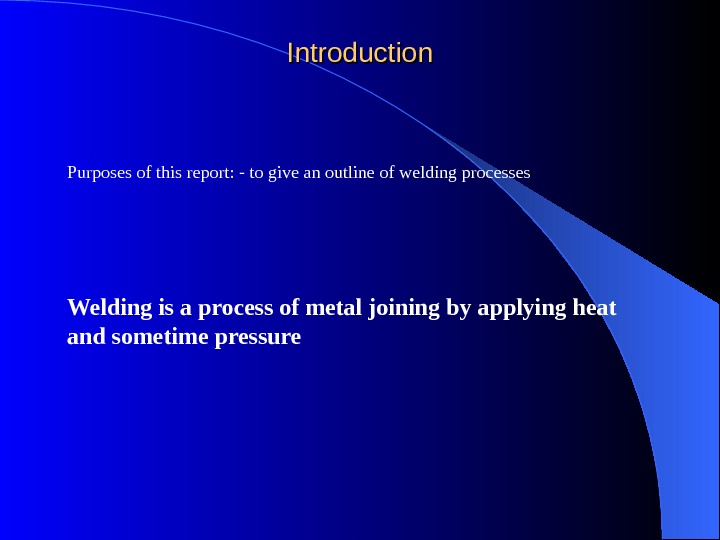
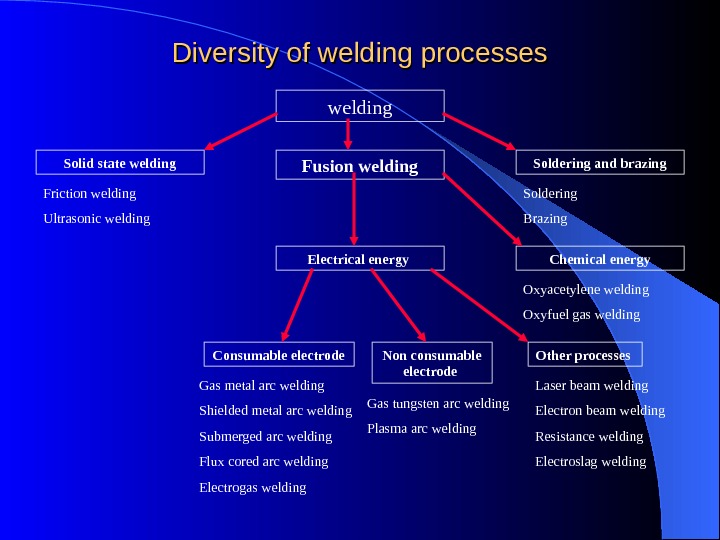




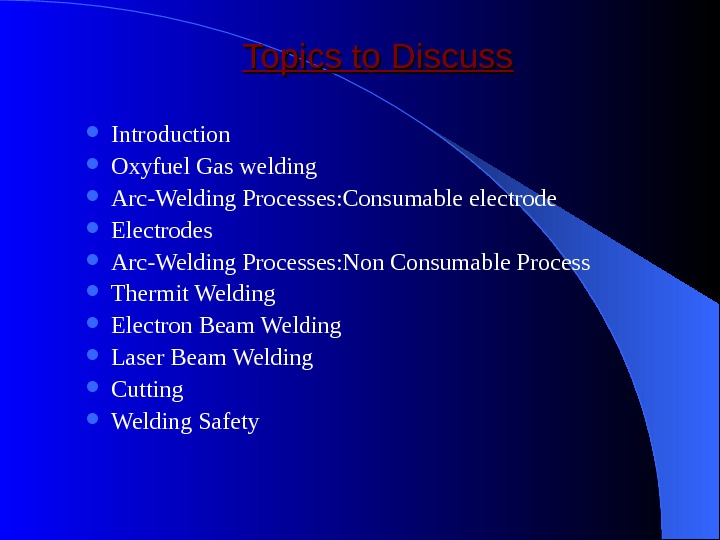

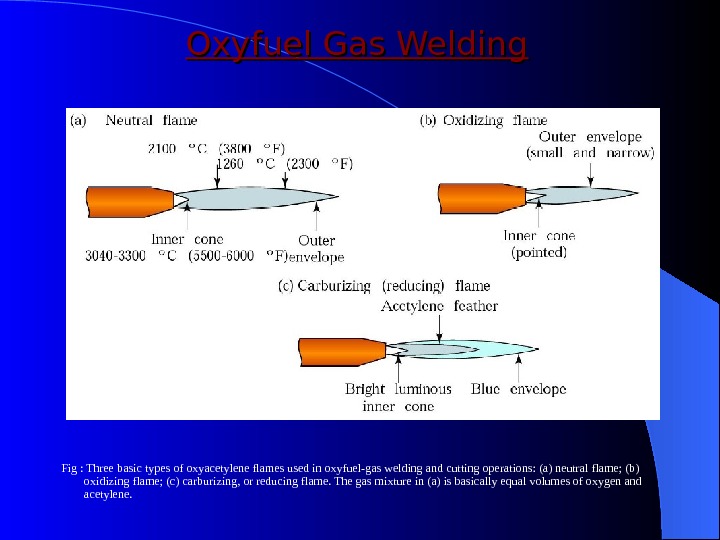


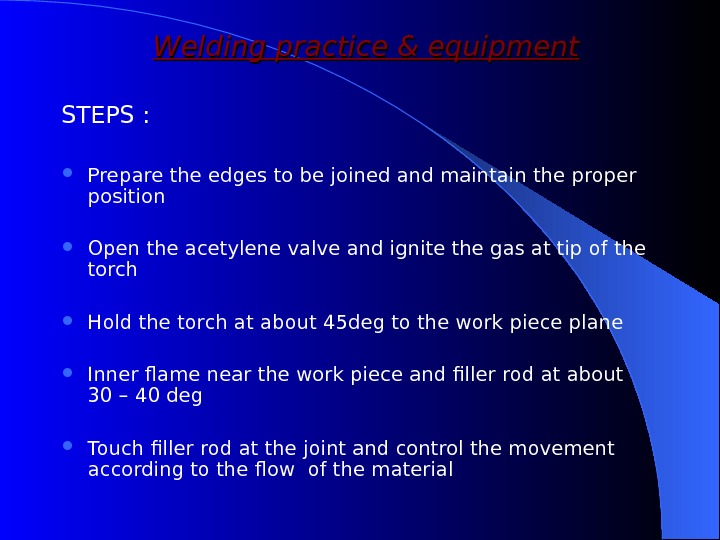
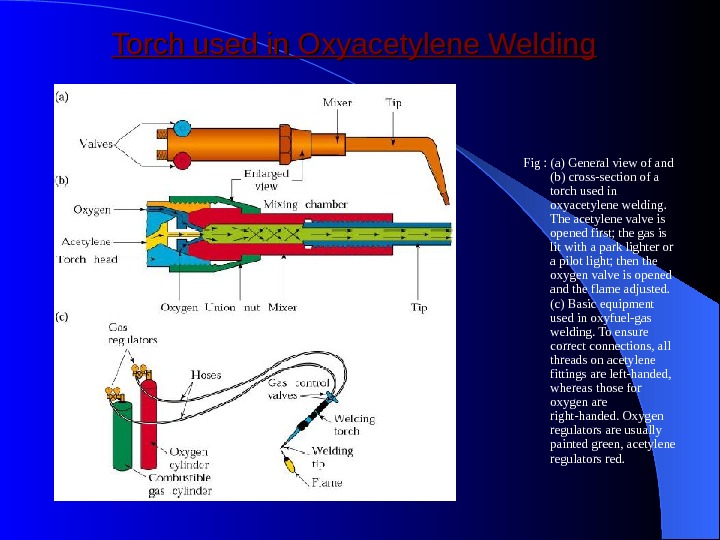

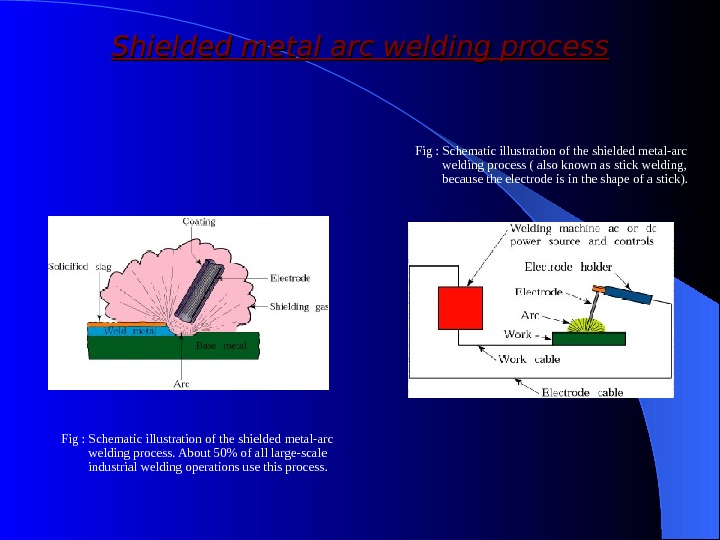




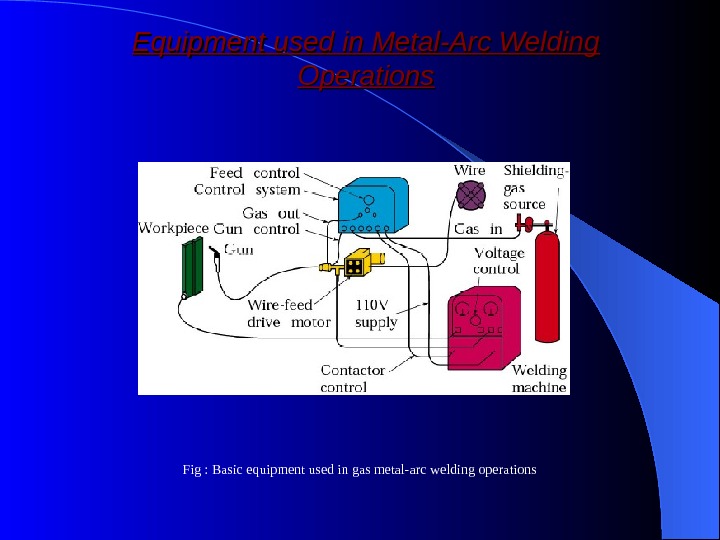
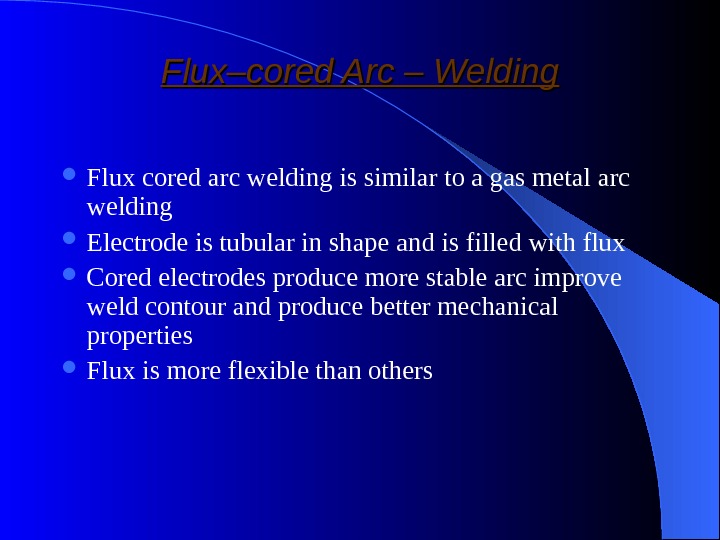

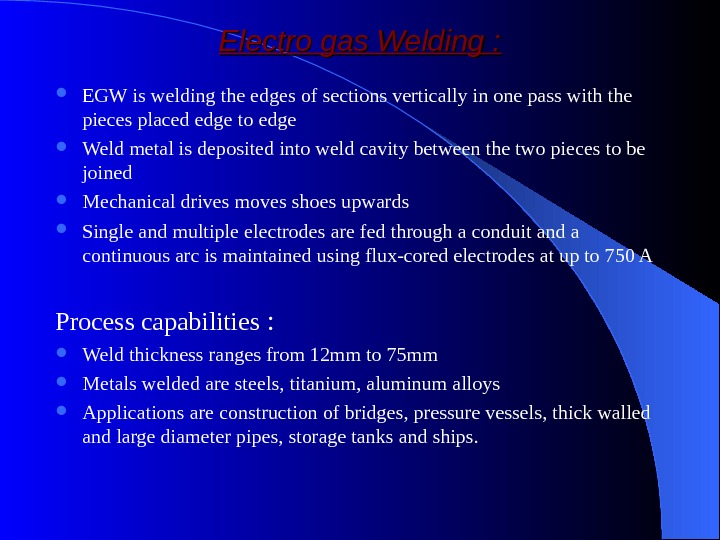

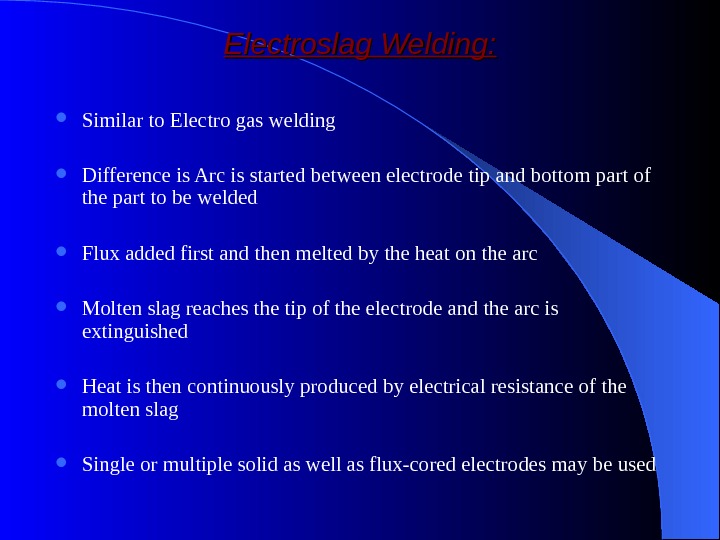


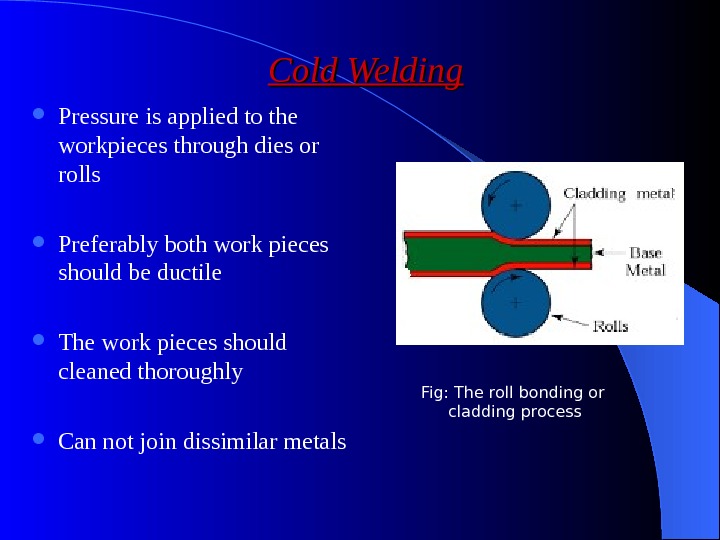
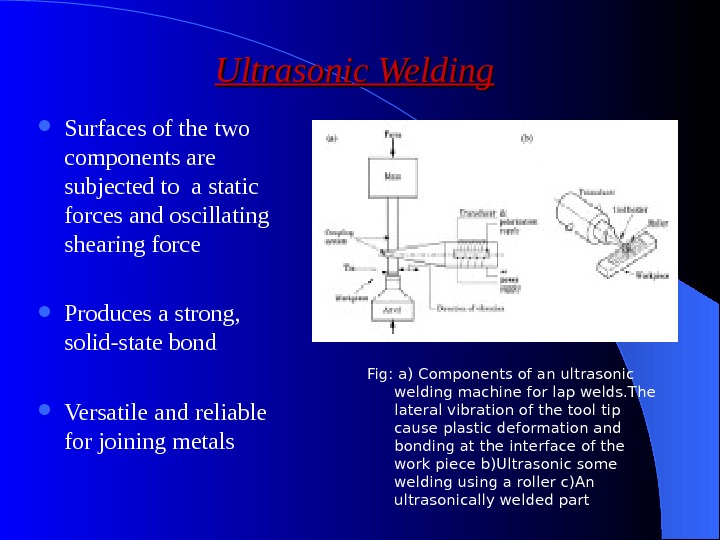
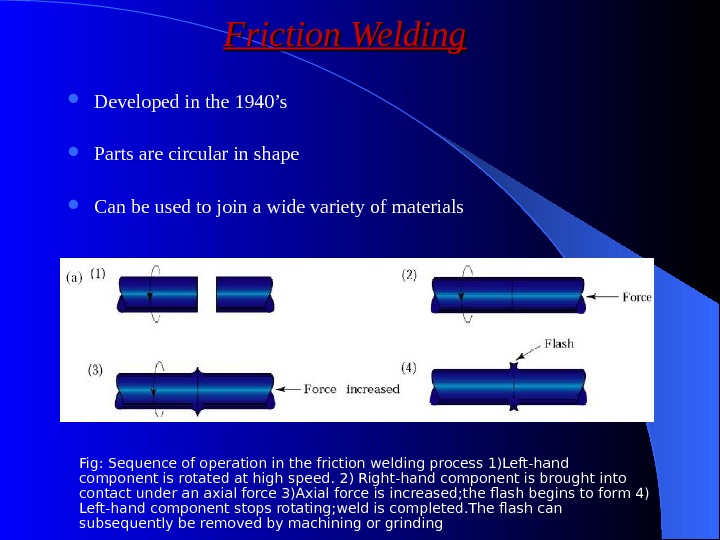

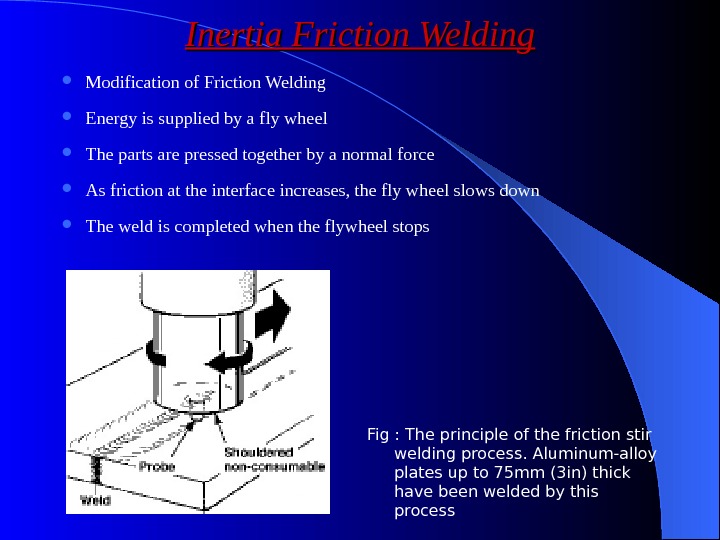






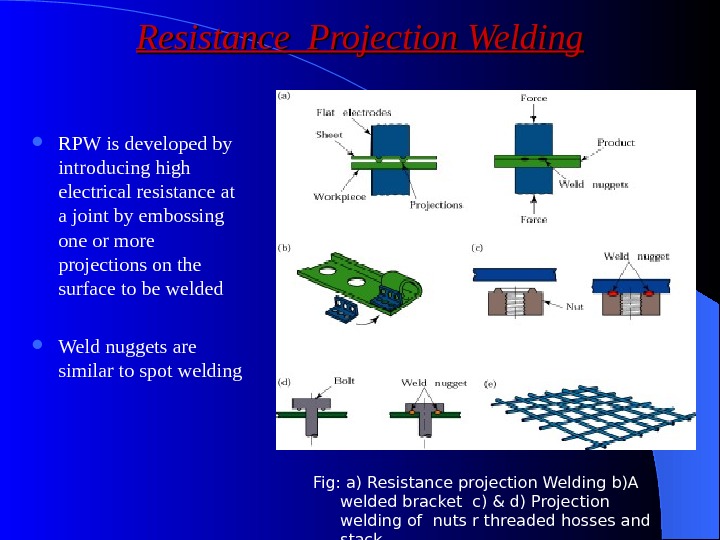
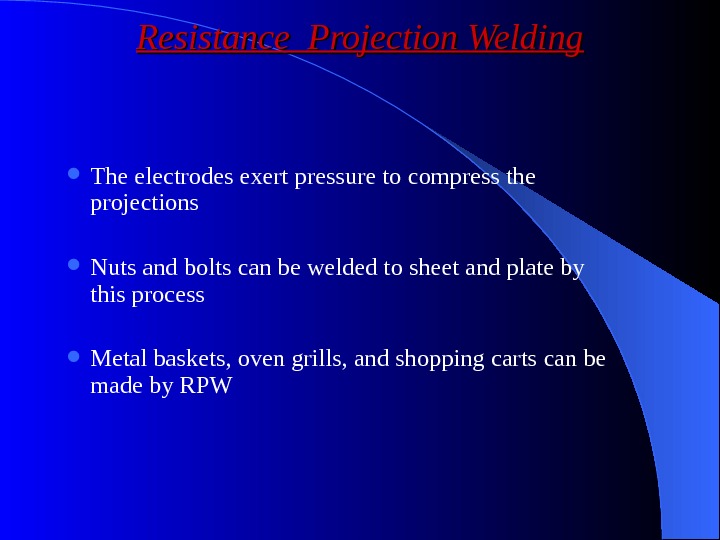
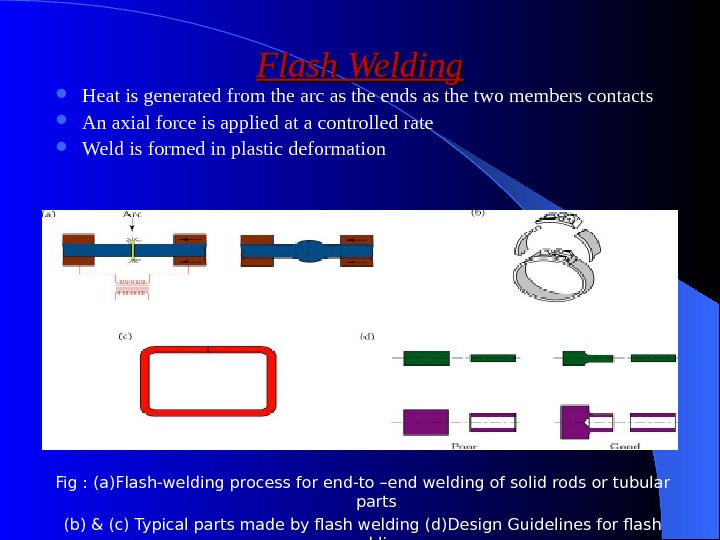


- Размер: 2.8 Mегабайта
- Количество слайдов: 44
Описание презентации Презентация welding-presentation по слайдам
 Welding process
Welding process
 Purposes of this report: — to give an outline of welding processes Welding is a process of metal joining by applying heat and sometime pressure Introduction
Purposes of this report: — to give an outline of welding processes Welding is a process of metal joining by applying heat and sometime pressure Introduction
 Diversity of welding processes welding Solid state welding Soldering and brazing Fusion welding Electrical energy Chemical energy Other processes Non consumable electrode Consumable electrode Friction welding Ultrasonic welding Gas metal arc welding Shielded metal arc welding Submerged arc welding Flux cored arc welding Electrogas welding Gas tungsten arc welding Plasma arc welding Oxyacetylene welding Oxyfuel gas welding Laser beam welding Electron beam welding Resistance welding Electroslag welding Soldering Brazing
Diversity of welding processes welding Solid state welding Soldering and brazing Fusion welding Electrical energy Chemical energy Other processes Non consumable electrode Consumable electrode Friction welding Ultrasonic welding Gas metal arc welding Shielded metal arc welding Submerged arc welding Flux cored arc welding Electrogas welding Gas tungsten arc welding Plasma arc welding Oxyacetylene welding Oxyfuel gas welding Laser beam welding Electron beam welding Resistance welding Electroslag welding Soldering Brazing
 Solid state welding It merges all the welding processes in which there is no fusion of the workpieces. For example, in the solid welding process named resistance seam welding, the welding join is produced in the wheel electrodes region by applied a current and a pressure without fusion of the base metal. The resistance seam welding (source: Modern Welding (p 73))
Solid state welding It merges all the welding processes in which there is no fusion of the workpieces. For example, in the solid welding process named resistance seam welding, the welding join is produced in the wheel electrodes region by applied a current and a pressure without fusion of the base metal. The resistance seam welding (source: Modern Welding (p 73))
 Soldering or brazing Filler metal: brass or solder Base metal Characteristics of a brazed or soldered joint In these processes, only the filler metals which join the two pieces to be welded are melted and not the base metal. The braze metals have higher melting temperatures than the solder metals.
Soldering or brazing Filler metal: brass or solder Base metal Characteristics of a brazed or soldered joint In these processes, only the filler metals which join the two pieces to be welded are melted and not the base metal. The braze metals have higher melting temperatures than the solder metals.
 Fusion welding This process involves the partial melting of the two members welded in the join region. The thermal energy required for this fusion is usually supplied by chemical or electrical means. Characteristics of the fusion weld joint (Manufacturing Engineering and Technology: p 820) Base metal melt + filler melt
Fusion welding This process involves the partial melting of the two members welded in the join region. The thermal energy required for this fusion is usually supplied by chemical or electrical means. Characteristics of the fusion weld joint (Manufacturing Engineering and Technology: p 820) Base metal melt + filler melt
 Fusion welding Process
Fusion welding Process
 Topics to Discuss Introduction Oxyfuel Gas welding Arc-Welding Processes: Consumable electrode Electrodes Arc-Welding Processes: Non Consumable Process Thermit Welding Electron Beam Welding Laser Beam Welding Cutting Welding Safety
Topics to Discuss Introduction Oxyfuel Gas welding Arc-Welding Processes: Consumable electrode Electrodes Arc-Welding Processes: Non Consumable Process Thermit Welding Electron Beam Welding Laser Beam Welding Cutting Welding Safety
 Introduction Definition : Fusion Welding is defined as melting together and coalescing materials by means of heat Energy is supplied by thermal or electrical means Fusion welds made without filler metals are known as autogenous welds
Introduction Definition : Fusion Welding is defined as melting together and coalescing materials by means of heat Energy is supplied by thermal or electrical means Fusion welds made without filler metals are known as autogenous welds
 Oxyfuel Gas Welding Fig : Three basic types of oxyacetylene flames used in oxyfuel-gas welding and cutting operations: (a) neutral flame; (b) oxidizing flame; (c) carburizing, or reducing flame. The gas mixture in (a) is basically equal volumes of oxygen and acetylene.
Oxyfuel Gas Welding Fig : Three basic types of oxyacetylene flames used in oxyfuel-gas welding and cutting operations: (a) neutral flame; (b) oxidizing flame; (c) carburizing, or reducing flame. The gas mixture in (a) is basically equal volumes of oxygen and acetylene.
 Oxyfuel Gas Welding process that uses fuel gas combined with oxygen to produce flame This flame heat melts the metals at the joint Acetylene fuel is used in gas welding process Primary combustion process C 2 H 2 + O 2 2 CO + H 2 + heat This reaction dissociates into carbon monoxide and hydrogen. Secondary combustion process 2 CO + H 2 + 1. 5 O 2 2 CO 2 + H 2 O + heat
Oxyfuel Gas Welding process that uses fuel gas combined with oxygen to produce flame This flame heat melts the metals at the joint Acetylene fuel is used in gas welding process Primary combustion process C 2 H 2 + O 2 2 CO + H 2 + heat This reaction dissociates into carbon monoxide and hydrogen. Secondary combustion process 2 CO + H 2 + 1. 5 O 2 2 CO 2 + H 2 O + heat
 Types of flames Neutral flame Oxidising flame Carburising flame Filler Metals : Additional material to weld the weld zone Available as rod or wire They can be used bare or coated with flux The purpose of the flux is to retard
Types of flames Neutral flame Oxidising flame Carburising flame Filler Metals : Additional material to weld the weld zone Available as rod or wire They can be used bare or coated with flux The purpose of the flux is to retard
 Welding practice & equipment STEPS : Prepare the edges to be joined and maintain the proper position Open the acetylene valve and ignite the gas at tip of the torch Hold the torch at about 45 deg to the work piece plane Inner flame near the work piece and filler rod at about 30 – 40 deg Touch filler rod at the joint and control the movement according to the flow of the material
Welding practice & equipment STEPS : Prepare the edges to be joined and maintain the proper position Open the acetylene valve and ignite the gas at tip of the torch Hold the torch at about 45 deg to the work piece plane Inner flame near the work piece and filler rod at about 30 – 40 deg Touch filler rod at the joint and control the movement according to the flow of the material
 Torch used in Oxyacetylene Welding Fig : (a) General view of and (b) cross-section of a torch used in oxyacetylene welding. The acetylene valve is opened first; the gas is lit with a park lighter or a pilot light; then the oxygen valve is opened and the flame adjusted. (c) Basic equipment used in oxyfuel-gas welding. To ensure correct connections, all threads on acetylene fittings are left-handed, whereas those for oxygen are right-handed. Oxygen regulators are usually painted green, acetylene regulators red.
Torch used in Oxyacetylene Welding Fig : (a) General view of and (b) cross-section of a torch used in oxyacetylene welding. The acetylene valve is opened first; the gas is lit with a park lighter or a pilot light; then the oxygen valve is opened and the flame adjusted. (c) Basic equipment used in oxyfuel-gas welding. To ensure correct connections, all threads on acetylene fittings are left-handed, whereas those for oxygen are right-handed. Oxygen regulators are usually painted green, acetylene regulators red.
 Arc welding process : Consumable electrode Process goes with the consumable electrode or non consumable electrode Arc produced between the tip of the electrode & work piece Arc temperature about 3000 deg Oldest , simple & versatile 50 % of industry uses this process heat generated heats the electrode & immediate area of the base projected by arc weld forms when molten metal , mixture of base metal and electrode metal and substance from the coating on the electrode solidifies electrodes are in the shape of thin, long stick, so the process is known as stick welding
Arc welding process : Consumable electrode Process goes with the consumable electrode or non consumable electrode Arc produced between the tip of the electrode & work piece Arc temperature about 3000 deg Oldest , simple & versatile 50 % of industry uses this process heat generated heats the electrode & immediate area of the base projected by arc weld forms when molten metal , mixture of base metal and electrode metal and substance from the coating on the electrode solidifies electrodes are in the shape of thin, long stick, so the process is known as stick welding
 Shielded metal arc welding process Fig : Schematic illustration of the shielded metal-arc welding process. About 50% of all large-scale industrial welding operations use this process. Fig : Schematic illustration of the shielded metal-arc welding process ( also known as stick welding, because the electrode is in the shape of a stick).
Shielded metal arc welding process Fig : Schematic illustration of the shielded metal-arc welding process. About 50% of all large-scale industrial welding operations use this process. Fig : Schematic illustration of the shielded metal-arc welding process ( also known as stick welding, because the electrode is in the shape of a stick).
 Submerged arc welding: Fig : Schematic illustration of the submerged-arc welding process and equipment. The unfused flux is recovered and reused.
Submerged arc welding: Fig : Schematic illustration of the submerged-arc welding process and equipment. The unfused flux is recovered and reused.
 Submerged arc welding: Weld arc is shielded by a granular flux , consisting of silica, lime, manganese oxide, calcium fluoride and other compounds. Flux is fed into the weld zone by gravity flow through nozzle Thick layer of flux covers molten metal Flux acts as a thermal insulator , promoting deep penetration of heat into the work piece Consumable electrode is a coil of bare round wire fed automatically through a tube Power is supplied by 3 -phase or 2 -phase power lines
Submerged arc welding: Weld arc is shielded by a granular flux , consisting of silica, lime, manganese oxide, calcium fluoride and other compounds. Flux is fed into the weld zone by gravity flow through nozzle Thick layer of flux covers molten metal Flux acts as a thermal insulator , promoting deep penetration of heat into the work piece Consumable electrode is a coil of bare round wire fed automatically through a tube Power is supplied by 3 -phase or 2 -phase power lines
 Gas metal arc welding: GMAW is a metal inert gas welding (MIG) Weld area shielded by an effectively inert atmosphere of argon, helium, carbon dioxide, various other gas mixtures Metal can be transferred by 3 methods : Spray transfer Globular transfer Short circuiting Process capabilities GMAV process is suitable for welding a variety of ferrous and non-ferrous metals Process is versatile , rapid, economical, welding productivity is double that of SMAW
Gas metal arc welding: GMAW is a metal inert gas welding (MIG) Weld area shielded by an effectively inert atmosphere of argon, helium, carbon dioxide, various other gas mixtures Metal can be transferred by 3 methods : Spray transfer Globular transfer Short circuiting Process capabilities GMAV process is suitable for welding a variety of ferrous and non-ferrous metals Process is versatile , rapid, economical, welding productivity is double that of SMAW
 Gas Metal-Arc Welding Fig : Schematic illustration of the gas metal-arc welding process, formerly known as MIG (for metal inert gas) welding.
Gas Metal-Arc Welding Fig : Schematic illustration of the gas metal-arc welding process, formerly known as MIG (for metal inert gas) welding.
 Equipment used in Metal-Arc Welding Operations Fig : Basic equipment used in gas metal-arc welding operations
Equipment used in Metal-Arc Welding Operations Fig : Basic equipment used in gas metal-arc welding operations
 Flux–cored Arc – Welding Flux cored arc welding is similar to a gas metal arc welding Electrode is tubular in shape and is filled with flux Cored electrodes produce more stable arc improve weld contour and produce better mechanical properties Flux is more flexible than others
Flux–cored Arc – Welding Flux cored arc welding is similar to a gas metal arc welding Electrode is tubular in shape and is filled with flux Cored electrodes produce more stable arc improve weld contour and produce better mechanical properties Flux is more flexible than others
 Flux-Cored Arc Welding Fig : Schematic illustration of the flux-cored arc-welding process. This operation is similar to gas metal-arc welding.
Flux-Cored Arc Welding Fig : Schematic illustration of the flux-cored arc-welding process. This operation is similar to gas metal-arc welding.
 Electro gas Welding : EGW is welding the edges of sections vertically in one pass with the pieces placed edge to edge Weld metal is deposited into weld cavity between the two pieces to be joined Mechanical drives moves shoes upwards Single and multiple electrodes are fed through a conduit and a continuous arc is maintained using flux-cored electrodes at up to 750 A Process capabilities : Weld thickness ranges from 12 mm to 75 mm Metals welded are steels, titanium, aluminum alloys Applications are construction of bridges, pressure vessels, thick walled and large diameter pipes, storage tanks and ships.
Electro gas Welding : EGW is welding the edges of sections vertically in one pass with the pieces placed edge to edge Weld metal is deposited into weld cavity between the two pieces to be joined Mechanical drives moves shoes upwards Single and multiple electrodes are fed through a conduit and a continuous arc is maintained using flux-cored electrodes at up to 750 A Process capabilities : Weld thickness ranges from 12 mm to 75 mm Metals welded are steels, titanium, aluminum alloys Applications are construction of bridges, pressure vessels, thick walled and large diameter pipes, storage tanks and ships.
 Electrogas Welding Fig : Schematic illustration of the electrogas welding process
Electrogas Welding Fig : Schematic illustration of the electrogas welding process
 Electroslag Welding: Similar to Electro gas welding Difference is Arc is started between electrode tip and bottom part of the part to be welded Flux added first and then melted by the heat on the arc Molten slag reaches the tip of the electrode and the arc is extinguished Heat is then continuously produced by electrical resistance of the molten slag Single or multiple solid as well as flux-cored electrodes may be used
Electroslag Welding: Similar to Electro gas welding Difference is Arc is started between electrode tip and bottom part of the part to be welded Flux added first and then melted by the heat on the arc Molten slag reaches the tip of the electrode and the arc is extinguished Heat is then continuously produced by electrical resistance of the molten slag Single or multiple solid as well as flux-cored electrodes may be used
 Equipment used in Electroslag welding Fig : Equipment used for electroslag welding operations.
Equipment used in Electroslag welding Fig : Equipment used for electroslag welding operations.
 Solid-State Welding Processes
Solid-State Welding Processes
 Cold Welding Pressure is applied to the workpieces through dies or rolls Preferably both work pieces should be ductile The work pieces should cleaned thoroughly Can not join dissimilar metals Fig: The roll bonding or cladding process
Cold Welding Pressure is applied to the workpieces through dies or rolls Preferably both work pieces should be ductile The work pieces should cleaned thoroughly Can not join dissimilar metals Fig: The roll bonding or cladding process
 Ultrasonic Welding Surfaces of the two components are subjected to a static forces and oscillating shearing force Produces a strong, solid-state bond Versatile and reliable for joining metals Fig: a) Components of an ultrasonic welding machine for lap welds. The lateral vibration of the tool tip cause plastic deformation and bonding at the interface of the work piece b)Ultrasonic some welding using a roller c)An ultrasonically welded part
Ultrasonic Welding Surfaces of the two components are subjected to a static forces and oscillating shearing force Produces a strong, solid-state bond Versatile and reliable for joining metals Fig: a) Components of an ultrasonic welding machine for lap welds. The lateral vibration of the tool tip cause plastic deformation and bonding at the interface of the work piece b)Ultrasonic some welding using a roller c)An ultrasonically welded part
 Friction Welding Developed in the 1940’s Parts are circular in shape Can be used to join a wide variety of materials Fig: Sequence of operation in the friction welding process 1)Left-hand component is rotated at high speed. 2) Right-hand component is brought into contact under an axial force 3)Axial force is increased; the flash begins to form 4) Left-hand component stops rotating; weld is completed. The flash can subsequently be removed by machining or grinding
Friction Welding Developed in the 1940’s Parts are circular in shape Can be used to join a wide variety of materials Fig: Sequence of operation in the friction welding process 1)Left-hand component is rotated at high speed. 2) Right-hand component is brought into contact under an axial force 3)Axial force is increased; the flash begins to form 4) Left-hand component stops rotating; weld is completed. The flash can subsequently be removed by machining or grinding
 Process can be fully automated Can weld solid steel bars up to 250 mm in outside diameter Fig: Shape of friction zone in friction welding, as a function of the force applied and the rotational speed Friction Welding
Process can be fully automated Can weld solid steel bars up to 250 mm in outside diameter Fig: Shape of friction zone in friction welding, as a function of the force applied and the rotational speed Friction Welding
 Inertia Friction Welding Modification of Friction Welding Energy is supplied by a fly wheel The parts are pressed together by a normal force As friction at the interface increases, the fly wheel slows down The weld is completed when the flywheel stops Fig : The principle of the friction stir welding process. Aluminum-alloy plates up to 75 mm (3 in) thick have been welded by this process
Inertia Friction Welding Modification of Friction Welding Energy is supplied by a fly wheel The parts are pressed together by a normal force As friction at the interface increases, the fly wheel slows down The weld is completed when the flywheel stops Fig : The principle of the friction stir welding process. Aluminum-alloy plates up to 75 mm (3 in) thick have been welded by this process
 Linear Friction Welding Parts are joined by a linear reciprocating motion Parts do not have to be circular or tubular In this application, one part is moved across the face of the other part using a balanced reciprocating mechanism
Linear Friction Welding Parts are joined by a linear reciprocating motion Parts do not have to be circular or tubular In this application, one part is moved across the face of the other part using a balanced reciprocating mechanism
 Friction Stir Welding (FSW) New Process for welding aerospace metals Research is being directed towards using this process for polymers FSW uses a 3 rd nonconsumable tool inserted between the two bodies to heat the material to be joined
Friction Stir Welding (FSW) New Process for welding aerospace metals Research is being directed towards using this process for polymers FSW uses a 3 rd nonconsumable tool inserted between the two bodies to heat the material to be joined
 Resistance Welding Developed in the early 1900’s A process in which the heat required for welding is produced by means of electrical resistance across the two components RW does not requiring the following : – Consumable electrodes – Shield gases – Flux
Resistance Welding Developed in the early 1900’s A process in which the heat required for welding is produced by means of electrical resistance across the two components RW does not requiring the following : – Consumable electrodes – Shield gases – Flux
 Resistance Spot Welding RSW uses the tips of two opposing solid cylindrical electrodes Pressure is applied to the lap joint until the current is turned off in order to obtain a strong weld Fig: (a) Sequence in the resistance spot welding
Resistance Spot Welding RSW uses the tips of two opposing solid cylindrical electrodes Pressure is applied to the lap joint until the current is turned off in order to obtain a strong weld Fig: (a) Sequence in the resistance spot welding
 Surfaces should be clean Accurate control of and timing of electric current and of pressure are essential in resistance welding Fig: b)Cross-section of a spot weld, showing the weld nugget and the indentation of the electrode on the sheet surfaces. This is one of the most commonly used process in sheet-metal fabrication and in automotive-body assembly. Resistance Spot Welding
Surfaces should be clean Accurate control of and timing of electric current and of pressure are essential in resistance welding Fig: b)Cross-section of a spot weld, showing the weld nugget and the indentation of the electrode on the sheet surfaces. This is one of the most commonly used process in sheet-metal fabrication and in automotive-body assembly. Resistance Spot Welding
 Resistance Seam Welding RSEM is modification of spot welding wherein the electrodes are replaced by rotating wheels or rollers The electrically conducting rollers produce a spot weld RSEM can produce a continuous seam & joint that is liquid and gas tight Fig : (a) Seam-Welding Process in which rotating rolls act as electrode (b) Overlapping spots in a seam weld. (c) Roll spot weld (d) Resistance-welded gasoline tank
Resistance Seam Welding RSEM is modification of spot welding wherein the electrodes are replaced by rotating wheels or rollers The electrically conducting rollers produce a spot weld RSEM can produce a continuous seam & joint that is liquid and gas tight Fig : (a) Seam-Welding Process in which rotating rolls act as electrode (b) Overlapping spots in a seam weld. (c) Roll spot weld (d) Resistance-welded gasoline tank
 Resistance Projection Welding RPW is developed by introducing high electrical resistance at a joint by embossing one or more projections on the surface to be welded Weld nuggets are similar to spot welding Fig: a) Resistance projection Welding b)A welded bracket c) & d) Projection welding of nuts r threaded hosses and stack
Resistance Projection Welding RPW is developed by introducing high electrical resistance at a joint by embossing one or more projections on the surface to be welded Weld nuggets are similar to spot welding Fig: a) Resistance projection Welding b)A welded bracket c) & d) Projection welding of nuts r threaded hosses and stack
 The electrodes exert pressure to compress the projections Nuts and bolts can be welded to sheet and plate by this process Metal baskets, oven grills, and shopping carts can be made by RPW Resistance Projection Welding
The electrodes exert pressure to compress the projections Nuts and bolts can be welded to sheet and plate by this process Metal baskets, oven grills, and shopping carts can be made by RPW Resistance Projection Welding
 Flash Welding Heat is generated from the arc as the ends as the two members contacts An axial force is applied at a controlled rate Weld is formed in plastic deformation Fig : (a)Flash-welding process for end-to –end welding of solid rods or tubular parts (b) & (c) Typical parts made by flash welding (d)Design Guidelines for flash welding
Flash Welding Heat is generated from the arc as the ends as the two members contacts An axial force is applied at a controlled rate Weld is formed in plastic deformation Fig : (a)Flash-welding process for end-to –end welding of solid rods or tubular parts (b) & (c) Typical parts made by flash welding (d)Design Guidelines for flash welding
 Stud Welding Small part or a threaded rod or hanger serves as a electrode Also called as Stud arc welding Prevent oxidation to concentrate the heat generation Portable stud-welding is also available Fig: The sequence of operation in stud welding, which is used for welding bars threaded rods and various fasteners onto metal plates
Stud Welding Small part or a threaded rod or hanger serves as a electrode Also called as Stud arc welding Prevent oxidation to concentrate the heat generation Portable stud-welding is also available Fig: The sequence of operation in stud welding, which is used for welding bars threaded rods and various fasteners onto metal plates
 THE EN
THE EN

